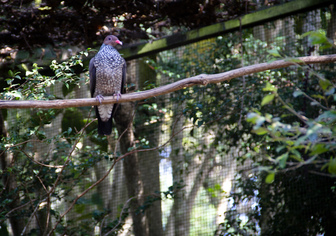Scaled Pigeon
The Scaled Pigeon, Patagioenas speciosa , is a large New World tropical dove. It is a resident breeder from southern Mexico south to western Ecuador, southern Brazil, northern Argentina, and Trinidad.

Original source: Thiago ValençaPermission(Reusing this file)This image was originally posted to Flickr by thijulio at http://flickr.com/photos/60650388@N08/5952703254. It was reviewed on 11 August 2011(2011-08-11) by the FlickreviewR robot and confirmed to be licensed under the terms of the cc-by-sa-2.0. This file is licensed under the Creative Commons Attribution-Share Alike 2.0 Generic license.You are free:to share – to copy, distribute and transmit the work
Author: Thiago ValençaPermission(Reusing this file)This image was originally posted to Flickr by thijulio at http://flickr.com/photos/60650388@N08/5952703254. It was reviewed on 11 August 2011(2011-08-11) by the FlickreviewR robot and confirmed to be licensed under the terms of the cc-by-sa-2.0. This file is licensed under the Creative Commons Attribution-Share Alike 2.0 Generic license.You are free:to share – to copy, distribute and transmit the work
The Scaled Pigeon is classified as Least Concern. Does not qualify for a more at risk category. Widespread and abundant taxa are included in this category.
English: Scaled Pigeon, Scaly-necked Pigeon Spanish: Paloma Escamada, Paloma Escamosa, Paloma Trocal Spanish (Argentine): Paloma trocal Spanish (Bolivia): Paloma trocal Spanish (Colombia): Paloma Escamada Spanish (Costa Rica): Paloma Escamosa Spanish (Honduras): Paloma escamosa Spanish (Mexico): Paloma Escamosa Spanish (Nicaragua): Paloma Escamosa Spanish (Paraguay): Paloma trocal Estonian: tähniktuvi Finnish: Suomukyyhky French: Pigeon ramiret Guarani: Pykasu mbatara Italian: Colomba squamata, Piccione squamato More
The Scaled Pigeon, Patagioenas speciosa (see Johnson et al., 2001), is a large New World tropical dove. It is a resident breeder from southern Mexico south to western Ecuador, southern Brazil, northern Argentina, and Trinidad. The Scaled Pigeon is fairly common in semi-open forest. It builds a stick platform nest in a tree and lays two white eggs. More
Scaled pigeonBirds in Suriname = - A beautiful picture of two of the largest pigeons in Suriname the Scaled Doves, made by Foek Chin Joe in Suriname. A bird of open places with bushes, especially savannas, but also open places in the forest region. It has a melancholy two-toned voice, that is a quite common sound in Suriname. More
The Scaled Pigeon is 36cm long and weighs normally about 290g. Adult males have mainly purple brown plumage, with a paler scaly appearance to the neck and underparts. The lower underparts are whitish edged with purple. The eyering, legs and bill are red, the latter having a white tip. The female is dull dark brown rather than purplish, and is slightly smaller than the male. More
Scaled Pigeon, a secretive inhabitant of the Atlantic forest canopy. To confound the problem they are not as vocal as other pigeons and so are easily overlooked. Count yourself lucky if you should see one, and make the most of the experience! It may be a while before you see your next one! Click on the images to enlarge them.FIGURE 1 - Pair, Mbaracay More
Family : Columbidae
Genus : Patagioenas
Species : speciosa
Authority : Gmelin, 1789
